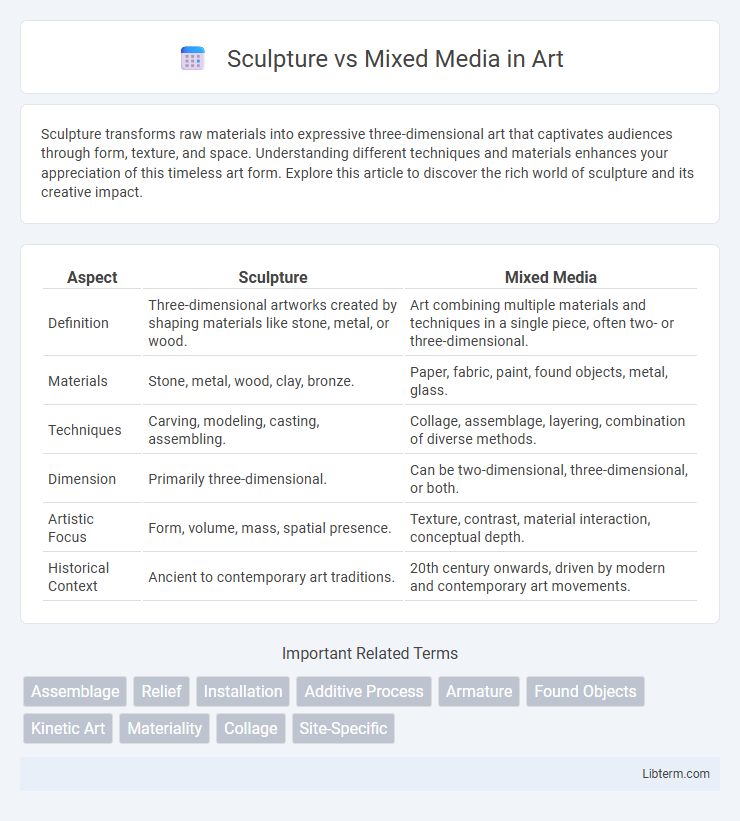Sculpture transforms raw materials into expressive three-dimensional art that captivates audiences through form, texture, and space. Understanding different techniques and materials enhances your appreciation of this timeless art form. Explore this article to discover the rich world of sculpture and its creative impact.
Table of Comparison
| Aspect | Sculpture | Mixed Media |
|---|---|---|
| Definition | Three-dimensional artworks created by shaping materials like stone, metal, or wood. | Art combining multiple materials and techniques in a single piece, often two- or three-dimensional. |
| Materials | Stone, metal, wood, clay, bronze. | Paper, fabric, paint, found objects, metal, glass. |
| Techniques | Carving, modeling, casting, assembling. | Collage, assemblage, layering, combination of diverse methods. |
| Dimension | Primarily three-dimensional. | Can be two-dimensional, three-dimensional, or both. |
| Artistic Focus | Form, volume, mass, spatial presence. | Texture, contrast, material interaction, conceptual depth. |
| Historical Context | Ancient to contemporary art traditions. | 20th century onwards, driven by modern and contemporary art movements. |
Introduction to Sculpture and Mixed Media
Sculpture, a three-dimensional art form, traditionally involves materials such as stone, metal, or wood to create tangible, physical expressions of form and space. Mixed media combines various artistic materials and techniques, integrating elements like paint, paper, fabric, and found objects to produce layered, textured works. Understanding the distinctions between sculpture and mixed media highlights the unique ways artists manipulate materials to explore depth, texture, and dimensionality in contemporary art.
Defining Sculpture: Traditional Forms and Techniques
Sculpture traditionally involves creating three-dimensional art by shaping materials such as stone, metal, or wood through carving, modeling, or casting techniques. These time-honored methods emphasize form, volume, and texture to produce tactile, standalone artworks. In contrast, mixed media incorporates diverse materials and processes, blending sculpture with other artistic mediums to expand creative expression beyond conventional boundaries.
What is Mixed Media? Exploring Creative Freedom
Mixed media refers to artworks created by combining various materials and techniques, such as paint, fabric, paper, and found objects, to achieve textural richness and visual complexity. Unlike traditional sculpture, which primarily involves carving or modeling in materials like stone, metal, or clay, mixed media offers greater creative freedom by allowing artists to experiment with diverse elements and unconventional materials. This versatility encourages innovative expressions and expands the boundaries of physical and conceptual art forms.
Historical Evolution of Sculpture and Mixed Media
Sculpture, rooted in ancient civilizations such as Mesopotamia and Egypt, evolved from stone and bronze carvings into dynamic forms during the Renaissance and modern periods. Mixed media emerged prominently in the 20th century, blending traditional sculptural materials with unconventional elements like fabric, found objects, and technology to challenge artistic boundaries. This historical evolution highlights a shift from singular material focus in sculpture to an integrative approach in mixed media, reflecting broader cultural and technological changes.
Material Choices: Classic vs. Experimental Approaches
Sculpture often relies on traditional materials such as marble, bronze, and wood, emphasizing durability and timeless aesthetics that have defined classical art for centuries. Mixed media embraces a broader spectrum of materials, integrating unconventional items like fabric, found objects, plastics, and digital components to challenge conventional boundaries and diversify texture and meaning. This experimental approach allows artists to explore hybrid forms and interdisciplinary techniques, pushing the evolution of contemporary art beyond the limits of classic sculpture.
Techniques and Tools: Differences and Overlaps
Sculpture primarily employs traditional tools such as chisels, hammers, and welding equipment to shape materials like stone, metal, and wood, emphasizing subtractive or additive techniques. Mixed media incorporates a broader range of tools from painting brushes to digital devices, enabling the combination of diverse materials like fabric, paper, and found objects within a single artwork. Both disciplines share overlapping methods such as assemblage and layering, allowing artists to experiment with texture, form, and dimensionality to convey complex visual narratives.
Expression and Concept: Artistic Intent in Both Forms
Sculpture emphasizes three-dimensional form and spatial relationships to convey emotion and narrative through physical presence, texture, and materiality, often engaging viewers in a tactile and visual dialogue. Mixed media combines diverse materials and techniques, expanding expressive possibilities by layering textures, colors, and symbolic elements to encapsulate complex concepts and multidimensional meanings. Both forms prioritize artistic intent by harnessing material choices and compositional strategies that evoke specific emotional responses and intellectual engagement, reflecting the artist's conceptual vision.
Prominent Artists in Sculpture and Mixed Media
Prominent artists in sculpture include Auguste Rodin, known for expressive bronze works like "The Thinker," and Louise Bourgeois, whose monumental spider sculptures explore psychological themes. In mixed media, artists such as Robert Rauschenberg revolutionized the art world by combining painting, sculpture, and found objects to create dynamic, layered compositions. Both disciplines emphasize three-dimensionality but differ in material usage, with sculpture often using traditional materials like marble and bronze, while mixed media embraces diverse, unconventional materials to challenge artistic boundaries.
Audience Engagement: Experiencing the Art Forms
Sculpture offers a tactile, three-dimensional experience that invites audiences to engage physically and spatially, often encouraging viewers to move around the piece to explore different perspectives. Mixed media combines various materials and techniques, creating layered textures and complex narratives that stimulate multiple senses and invite deeper intellectual interaction. Both art forms foster active participation, but mixed media often challenges viewers to interpret symbolism across diverse elements, enhancing emotional and cognitive engagement.
Future Trends: The Blending of Sculpture and Mixed Media
Future trends in art reveal an increasing fusion between sculpture and mixed media, where traditional three-dimensional forms integrate diverse materials such as textiles, digital components, and found objects. This convergence expands creative possibilities, enhancing tactile and visual experiences while challenging conventional boundaries of sculpture. Artists leverage this hybrid approach to explore themes of identity, technology, and environment, reflecting evolving cultural and technological landscapes.
Sculpture Infographic

 libterm.com
libterm.com